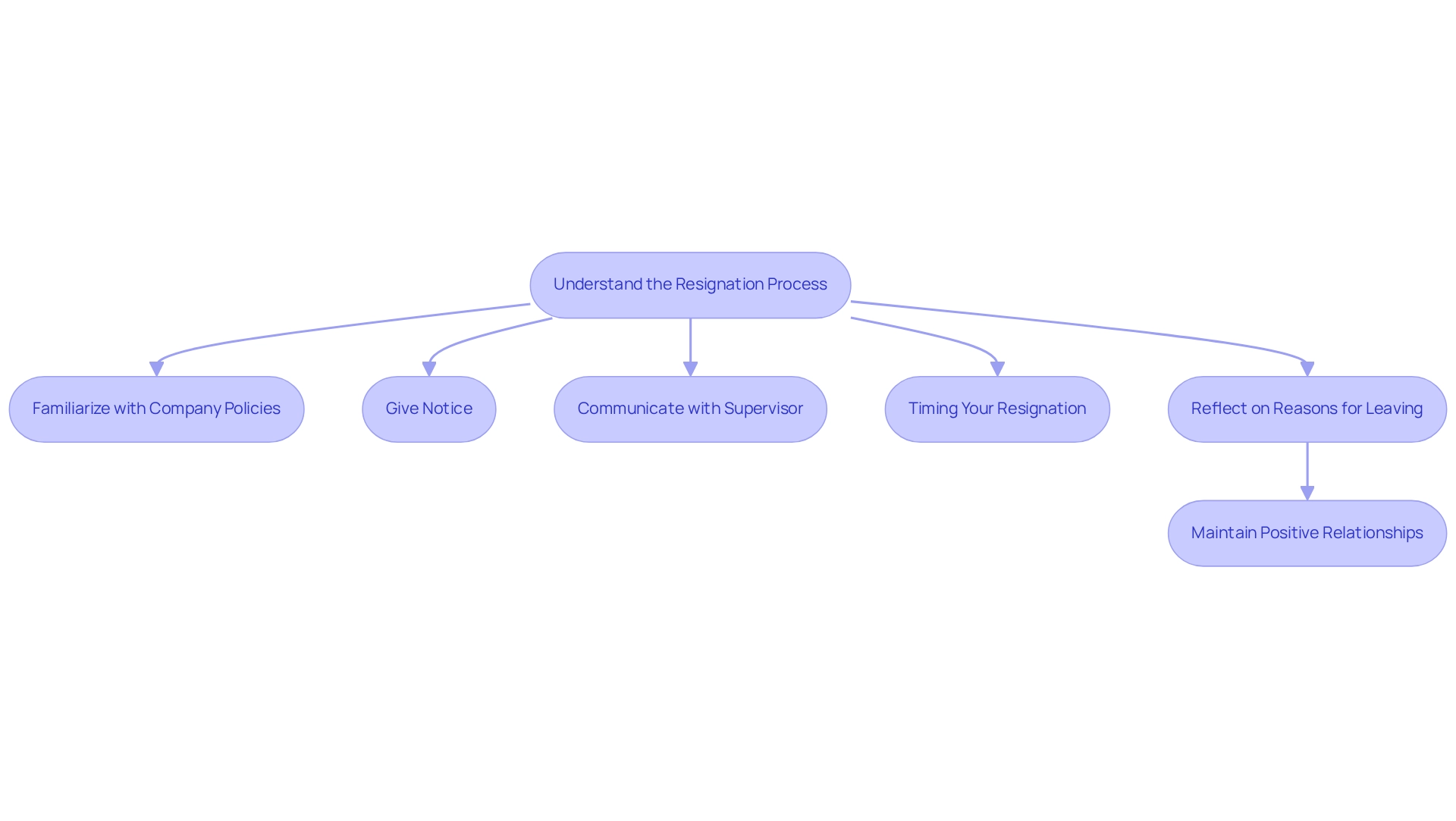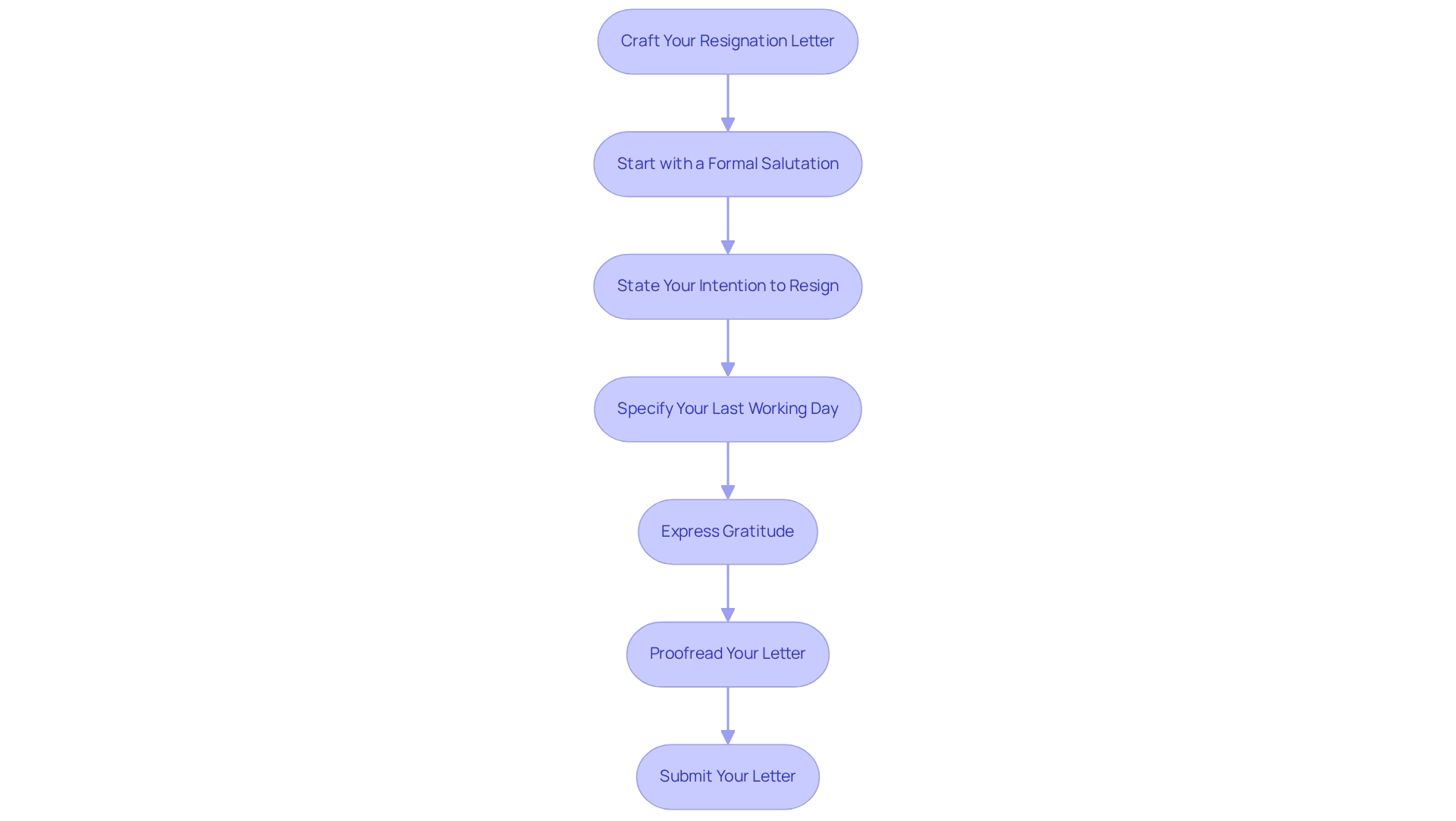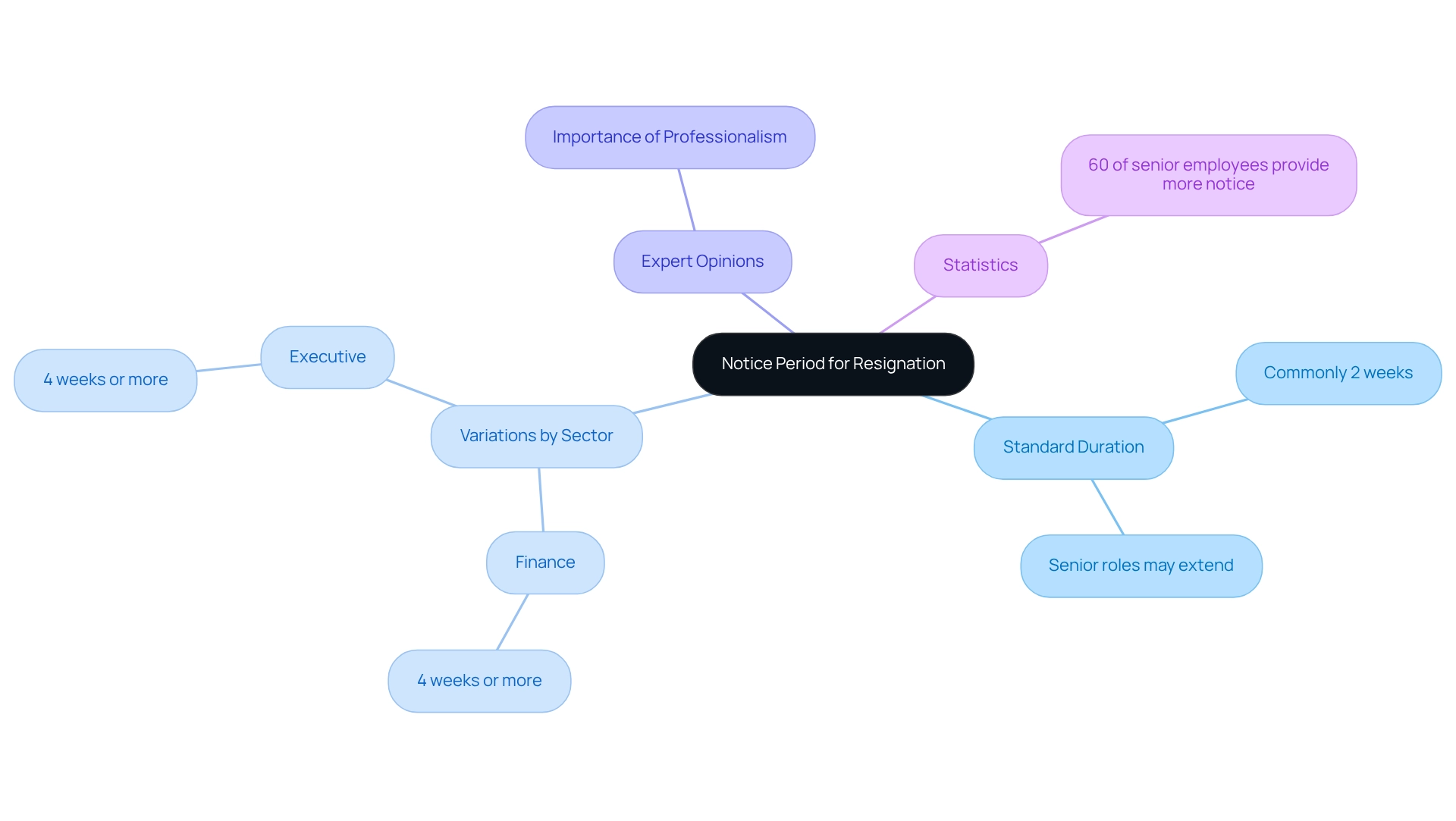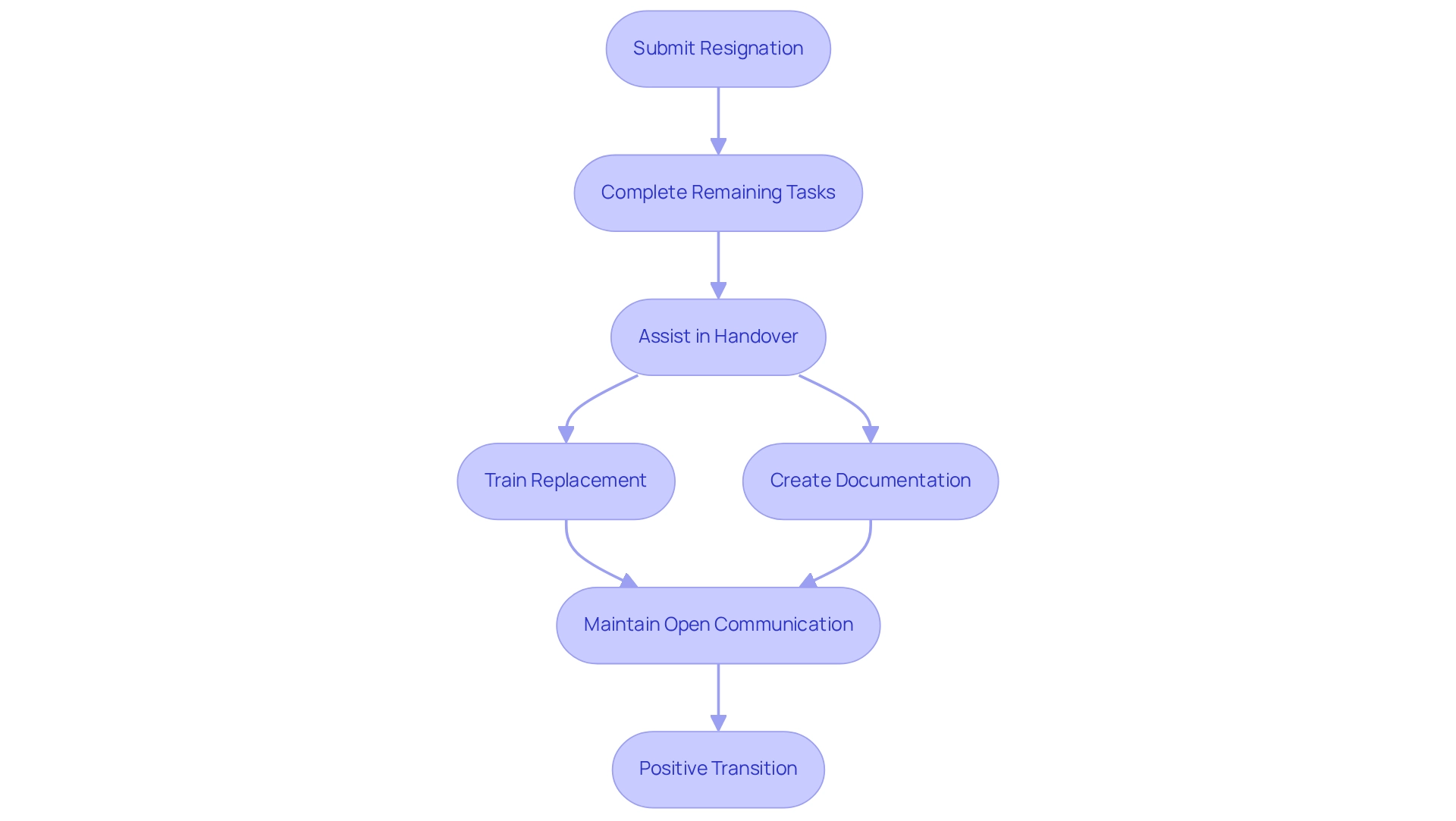Overview
To effectively give notice of resignation, one must adhere to a structured approach that encompasses:
- A thorough understanding of company policies
- Professional communication with supervisors
- The crafting of a concise resignation letter
This article delineates these essential steps, underscoring the significance of:
- Timing
- The expression of gratitude
- The facilitation of a smooth transition
Such practices are vital for maintaining positive relationships and upholding a professional image.
Key Highlights:
- Familiarize yourself with company-specific resignation policies and general etiquette before resigning.
- The standard notice period is typically two weeks, but this can vary by position and company.
- Prioritize communication with your supervisor to demonstrate professionalism and respect.
- Timing your resignation after completing significant projects can enhance your professional image.
- Reflect on your reasons for leaving to prepare for potential reactions from your employer.
- Craft a concise and professional resignation letter, expressing gratitude for opportunities received.
- Ensure your resignation letter includes a formal salutation, intention to resign, and last working day.
- Review your employment agreement for specific notice period requirements, which may vary.
- Consider extending your notice period if in a senior role or specialized position for a smoother transition.
- After resigning, complete remaining tasks and assist in training your replacement to ensure a seamless handover.
- Maintain open communication with your team during the transition to foster positive impressions.
Introduction
Navigating the resignation process is a critical undertaking, often fraught with emotional and professional complexities. It is imperative to grasp the nuances of submitting a resignation, crafting a formal letter, and managing the transition to ensure a graceful exit from one’s current position. This guide delves into the essential components of resigning—ranging from understanding company policies to articulating gratitude in a resignation letter—thereby facilitating a respectful and professional departure.
With a focus on notice periods and best practices for a seamless transition, this article empowers individuals with the necessary insights to preserve positive relationships and uphold their professional reputation as they embark on their next career endeavor.
Understand the Resignation Process
Before submitting your resignation, it is crucial to familiarize yourself with how to give notice of resignation, as well as your company’s specific resignation policies and the general etiquette associated with the process. Typically, when learning how to give notice of resignation, the standard advance notice across various sectors is two weeks; however, this can vary depending on the position and company. Many organizations in the U.S. adhere to this two-week notice period, so it is essential to know how to give notice of resignation according to your specific company’s policy.
Prioritizing communication with your supervisor before understanding how to give notice of resignation is vital, as it demonstrates professionalism and respect for the chain of command. As Ronald Reagan once said, “Goodbye, God bless you, and God bless the United States of America,” emphasizing the importance of a respectful farewell when leaving a position. Timing your resignation strategically, such as after completing a significant project, can further enhance your professional image.
Moreover, consider the emotional consequences of leaving your job; this change can be a major life event. Reflecting on your reasons for resigning will not only clarify your decision but also prepare you for potential reactions from your employer. Boutique Recruiting’s approach to building lasting relationships underscores the importance of maintaining positive connections during this process. Understanding these dynamics can help ensure a smoother transition and uphold positive relationships, which is vital in today’s interconnected professional landscape.

Craft Your Resignation Letter
A departure letter must be both concise and professional, demonstrating how to give notice of resignation as a formal notification of your exit. When learning how to give notice of resignation, start with a formal salutation, clearly state your intention to resign, and specify your last working day. It is essential to express gratitude for the opportunities you have had during your employment, as this fosters goodwill and maintains a positive relationship with your employer. An unnamed practice leader aptly observed, “Absolutely the most frustrated I have ever been in my career!” This underscores the importance of maintaining positive relationships, particularly in challenging times.
Here’s a straightforward template to guide you:
[Your Name]
[Your Address]
[City, State, Zip Code]
[Email Address]
[Date]
[Manager's Name]
[Company's Name]
[Company's Address]
[City, State, Zip Code]
Dear [Manager's Name],
I am writing to formally resign from my position as [Your Job Title] at [Company's Name], effective [Last Working Day]. I appreciate the opportunities for personal and professional development that you have provided me during my time here. Thank you for your support and guidance.
Sincerely,
[Your Name]
Before submitting your letter, ensure you proofread it for any errors. This attention to detail reflects your professionalism and respect for the organization. Industry insights indicate that maintaining professionalism in departure letters is essential, as it can significantly impact employer-employee relationships. With recent data revealing that the count of layoffs and discharges was adjusted to 1.8 million, the creation of a professional departure letter is more crucial than ever. A well-crafted departure letter demonstrates how to give notice of resignation, conveying your decision while leaving a lasting positive impression that can be advantageous for future references. Remember, expressing gratitude is not merely courteous; it can also enhance your professional reputation in the long run. As demonstrated by Boutique Recruiting’s track record of success, effective communication can lead to positive outcomes in employer-employee relationships. Furthermore, with the Job Openings and Labor Turnover Survey estimates for April 2025 scheduled to be published on June 3, 2025, the importance of professionalism in departures is underscored in the current job market.

Determine Your Notice Period
In 2025, understanding how to give notice of resignation typically involves a standard notification duration of two weeks across various sectors. However, this can vary based on your employment agreement or specific company regulations. It is essential to examine your agreement to confirm the required notification duration, as some organizations may impose distinct conditions. For individuals in senior roles or possessing specialized skills, extending your resignation period can prove beneficial, allowing your employer ample time to find a suitable replacement.
Expert opinions suggest that while two weeks is common, certain sectors may expect longer notification durations. For instance, in finance and executive positions, a notice period of four weeks or more is often recommended to ensure a seamless transition. Statistics reveal that approximately 60% of employees in senior roles opt to provide more than the standard advance notice, reflecting their commitment to their positions and the organization.
Understanding how to give notice of resignation is crucial when communicating your notice period clearly in both your resignation letter and during discussions with your manager. This transparency not only demonstrates professionalism but also helps maintain positive relationships as you transition to your next opportunity.

Manage the Transition After Resignation
Upon submitting your resignation, it is crucial to prioritize the completion of your remaining tasks and actively assist in the handover process. Consider offering to train your replacement or creating comprehensive documentation of your current projects to facilitate a seamless transition. Open communication with your team regarding your departure is essential; express your willingness to support them during this period. This proactive approach not only aids your employer in managing the change but also fosters a positive impression, invaluable for future references. As one specialist pointed out, “Your clients will now perceive your business as dependable, trustworthy, and informed, fostering long-term relationships,” underscoring the importance of maintaining positive connections during transitions.
Effective changes are essential; research indicates that properly managed employee transitions can significantly enhance team morale and productivity. Implementing best practices, such as structured training sessions for replacements, ensures efficient and thorough knowledge transfer. For instance, breaking down training into bite-sized modules, as demonstrated in a case study on creating product training materials, can enhance retention and engagement, leading to higher completion rates.
Additionally, establishing a clear handover process that includes timelines and key responsibilities is advisable. This structured approach clarifies expectations and empowers your successor to step into their role with confidence. By focusing on these strategies, you contribute to a smoother transition, reinforcing your reputation as a dedicated professional and aligning with the firm’s commitment to quality in personalized recruitment services.

Conclusion
Navigating the resignation process with care and professionalism is essential for ensuring a smooth transition to new opportunities. Understanding company policies, effectively communicating intentions to supervisors, and crafting a respectful resignation letter are crucial first steps. A well-written resignation letter not only expresses gratitude but also reinforces positive relationships, which can be invaluable for future references.
Determining the appropriate notice period is another critical aspect, as it varies by company and position. Providing adequate notice reflects professionalism and demonstrates a commitment to assisting the organization during the transition. For those in senior roles, extending the notice period can further enhance goodwill and facilitate a thorough handover of responsibilities.
Finally, actively managing the transition post-resignation is key to maintaining a positive professional reputation. By completing outstanding tasks, offering to train replacements, and facilitating knowledge transfer, individuals can leave a lasting impression that reflects their dedication and professionalism. The resignation process, when handled thoughtfully, can lead to valuable connections and opportunities in the future. As professionals embark on new journeys, the importance of a respectful and strategic departure cannot be overstated.
Frequently Asked Questions
What should I familiarize myself with before submitting my resignation?
Before submitting your resignation, it is crucial to understand how to give notice of resignation, your company’s specific resignation policies, and the general etiquette associated with the process.
What is the standard notice period for resignation?
The standard advance notice across various sectors is typically two weeks; however, this can vary depending on the position and company.
Why is communication with my supervisor important when resigning?
Prioritizing communication with your supervisor demonstrates professionalism and respect for the chain of command, which is vital during the resignation process.
When is a good time to submit my resignation?
Timing your resignation strategically, such as after completing a significant project, can enhance your professional image.
What emotional considerations should I keep in mind when resigning?
Leaving your job can be a major life event, so reflecting on your reasons for resigning can help clarify your decision and prepare you for potential reactions from your employer.
How can I maintain positive relationships after resigning?
Understanding the dynamics of your departure and prioritizing positive connections is essential for a smoother transition and maintaining relationships in today’s interconnected professional landscape.
{“@context”: “https://schema.org”, “@type”: “FAQPage”, “mainEntity”: [{“@type”: “Question”, “name”: “What should I familiarize myself with before submitting my resignation?”, “acceptedAnswer”: {“@type”: “Answer”, “text”: “Before submitting your resignation, it is crucial to understand how to give notice of resignation, your company’s specific resignation policies, and the general etiquette associated with the process.”}}, {“@type”: “Question”, “name”: “What is the standard notice period for resignation?”, “acceptedAnswer”: {“@type”: “Answer”, “text”: “The standard advance notice across various sectors is typically two weeks; however, this can vary depending on the position and company.”}}, {“@type”: “Question”, “name”: “Why is communication with my supervisor important when resigning?”, “acceptedAnswer”: {“@type”: “Answer”, “text”: “Prioritizing communication with your supervisor demonstrates professionalism and respect for the chain of command, which is vital during the resignation process.”}}, {“@type”: “Question”, “name”: “When is a good time to submit my resignation?”, “acceptedAnswer”: {“@type”: “Answer”, “text”: “Timing your resignation strategically, such as after completing a significant project, can enhance your professional image.”}}, {“@type”: “Question”, “name”: “What emotional considerations should I keep in mind when resigning?”, “acceptedAnswer”: {“@type”: “Answer”, “text”: “Leaving your job can be a major life event, so reflecting on your reasons for resigning can help clarify your decision and prepare you for potential reactions from your employer.”}}, {“@type”: “Question”, “name”: “How can I maintain positive relationships after resigning?”, “acceptedAnswer”: {“@type”: “Answer”, “text”: “Understanding the dynamics of your departure and prioritizing positive connections is essential for a smoother transition and maintaining relationships in today\u2019s interconnected professional landscape.”}}]}{“@context”: “https://schema.org”, “@type”: “BlogPosting”, “headline”: “4 Steps on How to Give Notice of Resignation Effectively”, “description”: “Learn how to give notice of resignation effectively with these four essential steps.”, “datePublished”: “2025-05-03T00:00:11.162000”, “image”: [“https://images.tely.ai/telyai/renvkqbq-each-box-represents-a-key-step-in-resigning-from-your-job-follow-the-arrows-to-understand-the-order-of-actions-and-considerations-needed-for-a-respectful-and-professional-resignation.webp”, “https://images.tely.ai/telyai/nvzcglzk-each-box-represents-a-step-in-the-process-of-writing-a-resignation-letter-follow-the-arrows-to-understand-how-to-move-from-one-part-to-the-next-its-a-straightforward-guide-to-help-you-craft-a-professional-and-concise-letter.webp”, “https://images.tely.ai/telyai/bdwwvjax-the-center-shows-the-main-topic-of-notice-periods-and-each-branch-represents-different-related-aspects-helping-you-visualize-how-they-connect-and-the-importance-of-each-in-the-resignation-process.webp”, “https://images.tely.ai/telyai/dgzkmzyk-each-box-represents-a-step-you-should-take-after-resigning-follow-the-arrows-to-see-the-order-of-actions-that-will-help-you-leave-your-position-positively-and-professionally.webp”], “articleBody”: “## Overview\nTo effectively give notice of resignation, one must adhere to a structured approach that encompasses:\n\n1. A thorough understanding of company policies\n2. Professional communication with supervisors\n3. The crafting of a concise resignation letter\n\nThis article delineates these essential steps, underscoring the significance of:\n\n- Timing\n- The expression of gratitude\n- The facilitation of a smooth transition\n\nSuch practices are vital for maintaining positive relationships and upholding a professional image.\n\n## Key Highlights:\n- Familiarize yourself with company-specific resignation policies and general etiquette before resigning.\n- The standard notice period is typically two weeks, but this can vary by position and company.\n- Prioritize communication with your supervisor to demonstrate professionalism and respect.\n- Timing your resignation after completing significant projects can enhance your professional image.\n- Reflect on your reasons for leaving to prepare for potential reactions from your employer.\n- Craft a concise and professional resignation letter, expressing gratitude for opportunities received.\n- Ensure your resignation letter includes a formal salutation, intention to resign, and last working day.\n- Review your employment agreement for specific notice period requirements, which may vary.\n- Consider extending your notice period if in a senior role or specialized position for a smoother transition.\n- After resigning, complete remaining tasks and assist in training your replacement to ensure a seamless handover.\n- Maintain open communication with your team during the transition to foster positive impressions.\n\n## Introduction\nNavigating the resignation process is a critical undertaking, often fraught with emotional and professional complexities. It is imperative to grasp the nuances of submitting a resignation, crafting a formal letter, and managing the transition to ensure a graceful exit from one’s current position. This guide delves into the essential components of resigning\u2014ranging from understanding company policies to articulating gratitude in a resignation letter\u2014thereby facilitating a respectful and professional departure. \n\nWith a focus on notice periods and best practices for a seamless transition, this article empowers individuals with the necessary insights to preserve positive relationships and uphold their professional reputation as they embark on their next career endeavor.\n\n## Understand the Resignation Process\nBefore submitting your resignation, it is crucial to familiarize yourself with how to give notice of resignation, as well as your company’s specific resignation policies and the general etiquette associated with the process. Typically, when learning how to give notice of resignation, the standard advance notice across various sectors is two weeks; however, this can vary depending on the position and company. Many organizations in the U.S. adhere to [this two-week notice period](https://www.boutiquerecruiting.com/how-to-give-a-notice-at-work-a-comprehensive-guide-for-employees/), so it is essential to know how to give notice of resignation according to your specific company’s policy.\n\nPrioritizing communication with your supervisor before understanding how to give notice of resignation is vital, as it demonstrates professionalism and respect for the chain of command. As Ronald Reagan once said, \”Goodbye, God bless you, and God bless the United States of America,\” emphasizing the importance of a respectful farewell when leaving a position. Timing your resignation strategically, such as after completing a significant project, can further enhance your professional image.\n\nMoreover, consider the emotional consequences of leaving your job; this change can be a major life event. Reflecting on your reasons for resigning will not only clarify your decision but also prepare you for potential reactions from your employer. Boutique Recruiting’s approach to building lasting relationships underscores the importance of maintaining positive connections during this process. Understanding these dynamics can help ensure a smoother transition and uphold positive relationships, which is vital in today’s interconnected professional landscape.\n\n\n## Craft Your Resignation Letter\nA departure letter must be both concise and professional, demonstrating how to give notice of resignation as a formal notification of your exit. When learning how to give notice of resignation, start with a formal salutation, clearly state your intention to resign, and specify your last working day. It is essential to express gratitude for the opportunities you have had during your employment, as this fosters goodwill and maintains a positive relationship with your employer. [An unnamed practice leader](https://mgma.com/mgma-stats/nurse-recruitment-and-hiring-after-the-great-resignation-still-a-major-challenge) aptly observed, \”Absolutely the most frustrated I have ever been in my career!\” This underscores the importance of maintaining positive relationships, particularly in challenging times.\n\nHere\u2019s a straightforward template to guide you:\n\n“`\n[Your Name] \n[Your Address] \n[City, State, Zip Code] \n[Email Address] \n[Date] \n\n[Manager’s Name] \n[Company’s Name] \n[Company’s Address] \n[City, State, Zip Code] \n\nDear [Manager’s Name],\n\nI am writing to formally resign from my position as [Your Job Title] at [Company’s Name], effective [Last Working Day]. I appreciate the opportunities for personal and professional development that you have provided me during my time here. Thank you for your support and guidance.\n\nSincerely, \n[Your Name]\n\n“`\n\nBefore submitting your letter, ensure you proofread it for any errors. This attention to detail reflects your professionalism and respect for the organization. Industry insights indicate that maintaining professionalism in departure letters is essential, as it can significantly impact employer-employee relationships. With recent data revealing that the count of layoffs and discharges was adjusted to 1.8 million, the creation of a professional departure letter is more crucial than ever. A well-crafted departure letter demonstrates how to give notice of resignation, conveying your decision while leaving a lasting positive impression that can be advantageous for future references. Remember, expressing gratitude is not merely courteous; it can also enhance your professional reputation in the long run. As demonstrated by Boutique Recruiting’s track record of success, effective communication can lead to positive outcomes in employer-employee relationships. Furthermore, with the Job Openings and Labor Turnover Survey estimates for April 2025 scheduled to be published on June 3, 2025, the importance of professionalism in departures is underscored in the current job market.\n\n\n## Determine Your Notice Period\nIn 2025, understanding how to give notice of resignation typically involves a standard notification duration of two weeks across various sectors. However, this can vary based on your employment agreement or specific company regulations. It is essential to examine your agreement to confirm the required notification duration, as some organizations may impose distinct conditions. For individuals in senior roles or possessing specialized skills, extending your resignation period can prove beneficial, allowing your employer ample time to find a suitable replacement. \n\nExpert opinions suggest that while two weeks is common, certain sectors may expect longer notification durations. For instance, in finance and executive positions, a notice period of four weeks or more is often recommended to ensure a seamless transition. Statistics reveal that approximately 60% of employees in senior roles opt to provide more than the standard advance notice, reflecting their commitment to their positions and the organization. \n\nUnderstanding how to give notice of resignation is crucial when [communicating your notice period](https://boutiquerecruiting.com) clearly in both your resignation letter and during discussions with your manager. This transparency not only demonstrates professionalism but also helps maintain positive relationships as you transition to your next opportunity.\n\n\n## Manage the Transition After Resignation\nUpon submitting your resignation, it is crucial to prioritize the completion of your remaining tasks and actively assist in the handover process. Consider offering to train your replacement or creating comprehensive documentation of your current projects to facilitate a seamless transition. Open communication with your team regarding your departure is essential; express your willingness to support them during this period. This proactive approach not only aids your employer in managing the change but also [fosters a positive impression](https://continu.com/blog/product-knowledge-training), invaluable for future references. As one specialist pointed out, \”Your clients will now perceive your business as dependable, trustworthy, and informed, fostering long-term relationships,\” underscoring the importance of maintaining positive connections during transitions.\n\nEffective changes are essential; research indicates that properly managed employee transitions can significantly enhance team morale and productivity. Implementing best practices, such as structured training sessions for replacements, ensures efficient and thorough knowledge transfer. For instance, breaking down training into bite-sized modules, as demonstrated in a case study on creating product training materials, can enhance retention and engagement, leading to higher completion rates.\n\nAdditionally, establishing a clear handover process that includes timelines and key responsibilities is advisable. This structured approach clarifies expectations and empowers your successor to step into their role with confidence. By focusing on these strategies, you contribute to a smoother transition, reinforcing your reputation as a dedicated professional and aligning with the firm’s commitment to quality in personalized recruitment services.\n\n\n\n## Conclusion\nNavigating the resignation process with care and professionalism is essential for ensuring a smooth transition to new opportunities. Understanding company policies, effectively communicating intentions to supervisors, and crafting a respectful resignation letter are crucial first steps. A well-written resignation letter not only expresses gratitude but also reinforces positive relationships, which can be invaluable for future references. \n\nDetermining the appropriate notice period is another critical aspect, as it varies by company and position. Providing adequate notice reflects professionalism and demonstrates a commitment to assisting the organization during the transition. For those in senior roles, extending the notice period can further enhance goodwill and facilitate a thorough handover of responsibilities. \n\nFinally, actively managing the transition post-resignation is key to maintaining a positive professional reputation. By completing outstanding tasks, offering to train replacements, and facilitating knowledge transfer, individuals can leave a lasting impression that reflects their dedication and professionalism. The resignation process, when handled thoughtfully, can lead to valuable connections and opportunities in the future. As professionals embark on new journeys, the importance of a respectful and strategic departure cannot be overstated.\n\n::iframe[https://iframe.tely.ai/cta/eyJhcnRpY2xlX2lkIjogIjY4MTU1YzhiYzZiMmVlZmZmYmY3YzgwYSIsICJjb21wYW55X2lkIjogIjY3YWU2NGU5YzhlZTg4N2E0ZmUzZmYxOSIsICJpbmRleCI6IG51bGx9]{width=\”100%\” height=\”300px\”}”}
